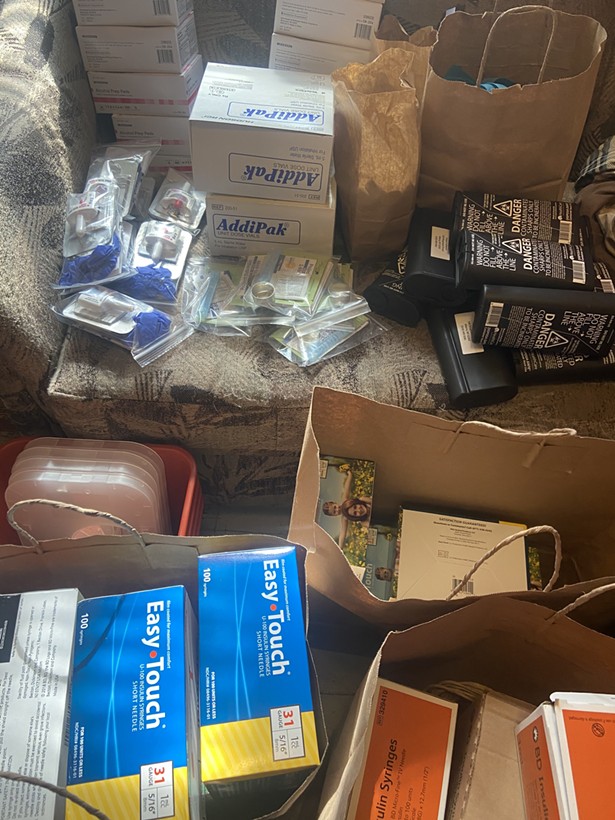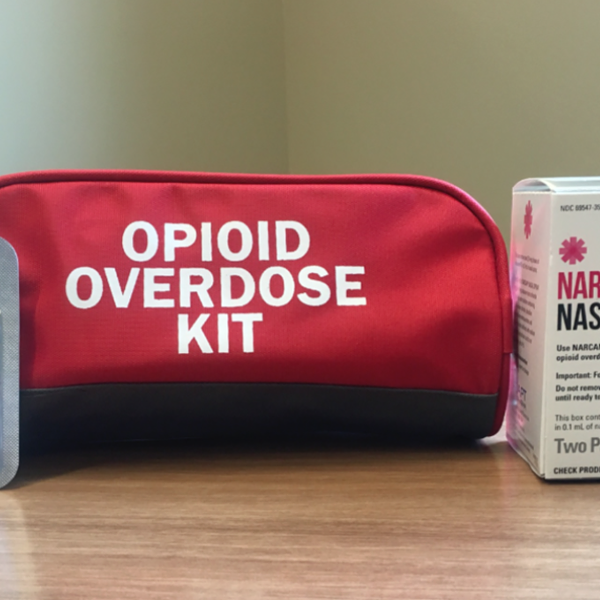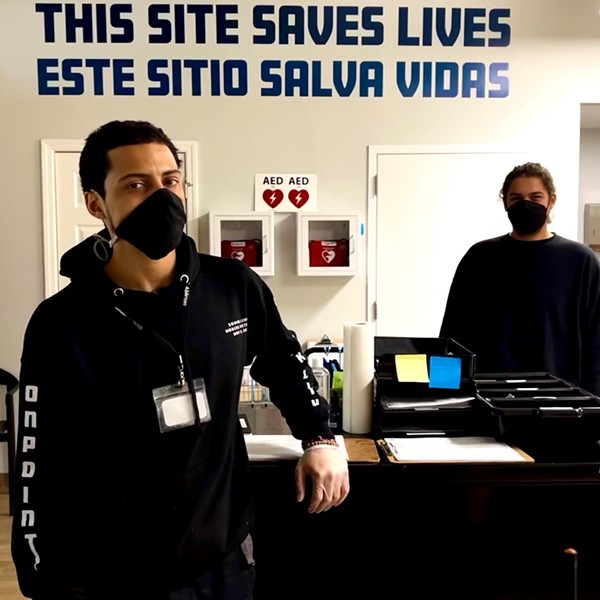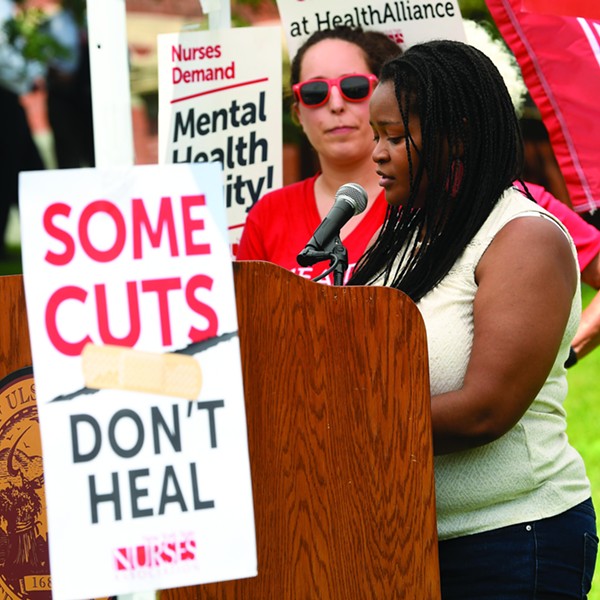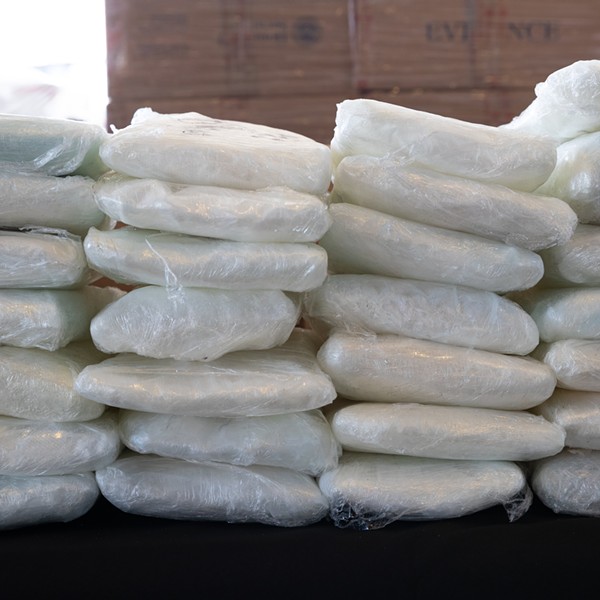The last thing Helen wanted was to be alone.
Despite her husband being asleep in the other room, Helen, who uses drugs intravenously, knew the risks associated with using heroin solo if something went south. (Her name has been changed to protect her privacy.) Her two-year pathway to addiction had followed the same trajectory as thousands of other Americans: after developing a dependency to prescription painkillers after a surgery, she started using harder drugs to stave off the symptoms of withdrawal once her doctor stopped delivering. Her use of opiates, which ended back in February, was a crash course in keeping herself and others alive. She and fellow users she linked up with in her stretch of Georgia knew that all the safeguards weren’t enough. All the Narcan by their side and clean needles at their disposal could only go so far in saving your life if no one else is there to help. Isolation is the enemy.
One day during the summer of 2019, Helen made the first of several calls to the Never Use Alone phone line, before going through the motions of using. Since its launch in August 2019, the entirely volunteer-run phone line has lent a helping hand—or in this case, ear—to active drug users like Helen before, during, and after they use their substance of choice.
Helen connected with an NUA operator, who wrote down her location. She was then free to use with no judgment or jargon, knowing that there was someone on the other end ready to call EMS in her area if anything went wrong. As she went through the ritual of setting up, drawing the heroin into the syringe, and injecting herself, the operator stayed on the line making sure to keep her engaged with light chit-chat. That initial 10-minute call left a good enough impression on Helen that she decided to share the hotline with others in her circle.
“If I tell them something’s okay, they believe me,” Helen says. “I just told them, ‘Look, I’m not always gonna be here, but I want you to always be here. So let’s call this number and let me show you something.’”
Many of the staff at NUA have dealt with addiction themselves or have backgrounds in harm-reduction work, and they understand that it’s crucial to meet people where they’re at. They never judge, going so far as refraining from recommending treatment options to callers unless they ask for it. The main goal is to make sure whoever calls makes it through that session alive. Depending on the circumstance, that one call could be the difference between living another day or succumbing to the ever-present threat of an overdose.
“It’s a stressful gig: You got somebody on the other line that could be dying and it’s traumatic for a lot of people,” says Mike Brown, NUA founder and an overdose prevention specialist at Harm Reduction Michigan.
The stakes are higher than ever, with harm reduction services and treatment providers having to contend with a significant spike in opioid overdoses and deaths across the country in the midst of the coronavirus pandemic. Since lockdowns began nationwide in March, NUA’s weekly call volume has tripled, going to 60 or 70 calls a day, Brown says.
Activists and advocates across the board agree that the combined psychological and economic stress of the current moment has worsened what was already a dire drug epidemic, now with the concurrent crisis of a worldwide pandemic. It’s a problem that in some respects has touched just as many as COVID-19 has, taking hundreds of thousands of lives in communities nationwide in the last couple of decades. At its worst, opioid overdoses took a life every 20 minutes, fueled by an influx of prescription medications and compounded by the introduction of fentanyl—an opioid 50 times stronger than heroin—into the illicit drug supply.
In the Hudson Valley and the Catskills, as with everywhere else, the problem has only worsened, according to data gathered by the Catskills Addiction Coalition from various public health departments. For instance, between January and June, Ulster County saw 201 overdoses (fatal and nonfatal), a 54 percent increase from the same timeframe last year. Delaware County has surpassed the number of overdoses it had in 2019 by 83 percent.
Unconventional Solutions
The work and solutions required to combat the epidemic in 2020 are as diverse as they are divisive. Even research-backed interventions, such as clean syringes to cut down on the transmission of bloodborne diseases like Hepatitis C and HIV or the overdose reversal drug naloxone (Narcan) that has saved thousands in the last few years, aren’t inured to criticism from skeptics who see them as impediments to people quitting cold turkey.
“Recovery involves sometimes using drugs. It’s a whole paradigm shift,” says Julia Reischel, a member of the Catskills Addiction Coalition. (Reischel is married to River staff writer Lissa Harris.) For the last couple of years, Reischel and the CAC team have helped foster stronger ties between treatment providers in the region and have conducted outreach to those suffering from substance use disorder. While some may not approve, Reischel believes that outreach requires working with people like Paul Fontana, a person in recovery and a former drug dealer, to get supplies to the people who need them the most.
Fontana, who lives in Delhi, has used the connections he made while dealing and in recovery to build a network of a dozen people who help him distribute over 6,000 syringes and dozens of Narcan kits he sources from Margaretville Hospital, the Delhi Police Department, and various nonprofits. His decision to become an outreach worker was spurred by the disillusionment he felt during court-mandated treatments that pushed abstinence over medication-assisted treatments (MAT) that use drugs like suboxone or methadone to curb cravings and withdrawal symptoms, and have been proven to be more effective. A February 2020 study examined insurance claims from over 40,000 patients diagnosed with substance use disorder over a two-year period to compare the efficacy of different treatment pathways, including no treatment. Treatment with buprenorphine or methadone led to a 76 percent reduction in overdose risk at three months and a 59 percent reduction at 12 months, as well as significant declines in opioid-related care. There were no such reductions in overdose risk or care needs with naltrexone or any of the other non-medication-assisted treatment pathways.
“You got to go places that not a lot of people and organizations are really willing to go,” Fontana says about his unconventional work. He and Reischel hope that their shared success will shift the public perception towards supporting harm reduction programs and non-abstinence based forms of treatment like MAT. The relationship harm reductionists like Reischel or Fontana have with local law enforcement can be spotty, but has gradually shifted over time.
Delaware County Sheriff Craig DuMond says that over the past five years, his department has provided data and input to the coalition, while they reciprocate by guiding the department on the use of Narcan in the field. While DuMond sees the value of Narcan as a lifesaving measure, he thinks needle exchange programs enable unproductive behavior and don’t help put people towards the path to recovery. He also believes law enforcement and drug courts can help keep people suffering with addiction accountable during the recovery process by creating a captive audience.
“It’s weird to say, but I’ve had a number of people who’ve lost family members and friends to the opioid epidemic and said, ‘We only wish they were arrested sooner so they could’ve been mandated the help that they need. Maybe it would’ve saved their lives,’” DuMond says.
According to him, a public health approach shouldn’t aid or ignore prosecuting those selling drugs. People want change and want to help, but when that help includes working with former drug dealers, they tend to resist, Reischel notes.
For Helen, and other users in her region, that kind of change can be slow if it happens at all. Needle exchange programs weren't legalized statewide in Georgia until April of 2019. Before then, people in her neck of the woods would have to make the two-and-a-half hour trek to Atlanta to access local programs there. The situation remains the same in terms of access to MAT, with many of Georgia’s highest-need counties lacking enough providers to meet demand. In that kind of sparse treatment landscape, a resource like NUA becomes a lifeline. Here in upstate New York, it can be a supplement to preexisting programs that might not always be available 24/7.
Meeting the Community Where They Are
On a late Thursday morning, an inconspicuous white van pulls into the sun-drenched parking lot of the Sullivan County Federation for the Homeless in Monticello. Every Monday and Thursday, the mobile Syringe Exchange program van—one of several outreach and prevention programs run by Hudson Valley Community Services—discreetly delivers valuable life-saving supplies such as clean needles, bleach kits, fentanyl test strips, and Narcan to anyone who visits them.
This help is particularly needed in Sullivan County, which tops the state’s list of highest overdose death rates. Sullivan had 92 overdoses in the first quarter of this year (seven fatal, another 63 requiring naloxone), double the amount seen during the same timeframe last year, according to public health officials. The stigma that still persists in rural areas like it often lead many suffering from substance use disorders to seek whatever safety or treatment options they can find, even if it means venturing outside their town or county.
“We find that people who are accessing the van in Poughkeepsie are not necessarily from there,” says Jay Dewey, the director of public relations and resource enhancement at Hudson Valley Community Services. “They may come down from Kingston or come up from Newburgh because they don’t want to go to the one that’s closest to them, in case someone sees them there.” As a result, weekly stops in Monticello or Newburgh in Orange County attract swaths of newcomers and familiar faces.
“We also have people that come back after getting clean to see us and thank us for helping them through the hard times,” says Christina Paliotta-Southwell, the program coordinator for Sullivan and Orange counties. “It’s not that often but it’s nice to see.”
What used to be a much more personal operation run by Paliotta-Southwell and prevention specialist Maurice Bacote has had to adapt to the latest safety guidelines. No longer are people able to sit in the van and chat with the duo as they get what they need. Now, it’s often a quick, handsfree exchange through the van’s sliding window. Besides the casual conversation and life stories the one-on-one interactions bring out, Paliotta-Southwell says that she and Bacote lose out on the view-from-the-streets perspective on current drug trends they get from seasoned users, which isn’t easily drawn out by data on Narcan distribution alone.
Back when the statewide lockdown was in full swing, she remembers anecdotally hearing about the rise in overdoses in Sullivan County, which could partially be attributed to a disruption in the local drug supply and the release of nonviolent drug offenders spurred by coronavirus outbreaks in state prisons. An abrupt drop to the local drug supply could heighten the risk of overdose for opioid users who would experience withdrawals or drops in their tolerance. For many advocates, pinpointing which conditions lead to these surges becomes difficult without on-the-ground intel.
Opening the dialogue on an otherwise taboo subject becomes crucial. Reischel recalls hearing about a local Delaware County woman whose overdose death in June was not publicly acknowledged by her family for fear of the shame.
“She died alone. She was secretly using, her kids found her, and everybody in the recovery community came to her funeral,” Reischel says.
Even choosing to look the other way can have consequences, as it only pushes people struggling with substance use deeper into isolation. To reduce the risks associated with using opiates and other substances, harm reductionists believe that society at large has to come to terms with the fact that substance use, and the repeated cycles of relapse and recovery that come with it, are a part of life.
“We have to acknowledge that people are dying and children are being left orphaned because of our overdose crisis in this country,” Reischel says. “And if we don’t want more orphans and more dead people, we have to meet people where they are, and that means where they’re using drugs.”
Tried and True Methods in a New Legal Environment
The work Paliotta-Southwell, Fontana, and other harm reduction advocates do is nothing new. It builds on the traditions of activists who operated the first syringe exchange programs and Narcan distribution platforms out of major drug hotspots like New York City, Seattle, and San Francisco in the 1970s and 80s.
What has changed is the legality. While Fontana and company have managed to forge careful connections with law enforcement, precursor organizations regularly skirted state laws to advance the cause.
“People used to get together on a weekly basis, have a potluck, and assemble these kits—these harm reduction and Naloxone kits—so that they could give them out during the week,” says Professor Nancy Campbell, a historian at Rensselaer Polytechnic Institute and author of OD: Naloxone and the Politics of Overdose.
As long as America has employed a punitive approach to treat substance use disorder, there have always been those who have doubted the efficacy of such a strategy. In response to the growing morphine epidemic of the 1920s and 30s, the federal government’s first try at drug user rehabilitation came in the form of the Narcotic Farms: two sprawling facilities in Lexington, Kentucky, and Fort Worth, Texas, that tried to cure addiction through a regimen of hard work and discipline in a prisonlike setting that ran into the 1970s. During that time, law enforcement used early overdose reversal drugs like nalorphine to discourage opioid use in patients by inducing uncomfortable side effects in users.
The recovery landscape in the United States changed rapidly with the passing of the Narcotic Addict Rehabilitation Act (NARA) of 1966. NARA essentially passed the responsibility of treating addiction over to individual states using whatever programs they saw fit. The deregulated environment NARA created ended up being a double-edged sword for harm reductionists: not only did it boost the profile and resources for MAT-like methadone clinics, but it gave less-effective, abstinence-only AA-based groups equal access to the same federal funds from state governments, Dr. Campbell explains.
Unfortunately, the decentralized environment that helped harm reductionists might also end up hurting them if nothing is done. State coffers are still reeling from the economic damage left by the pandemic, so much so that some are cutting millions in funding from drug treatment programs in a bid to save money.
After a months-long delay in state funding, HVCS was told its budget would be slashed by 20 percent this year. Regional programs across New York have seen their budgets reduced after the Cuomo administration announced a 31 percent cut in funding to substance abuse treatment programs in August.
When asked whether these cuts were permanent, a spokesman for the Governor’s budget office said the duration of New York’s cash crunch will entirely depend on whether the federal government sends more aid to the states. When the first CARES Act passed in March, less than one percent of the $2.2 trillion bill was earmarked for behavioral health programs, which includes substance abuse treatment.
Federal planning and state programs that award grants to support the work of independent contractors like Fontana should remain unaffected, for now. But nonprofits like Hudson Valley Community Services could see a reduction in services if cuts were to continue, Dewey says.
In an interview with Spectrum News in July, Executive Director of the New York State Association of Alcoholism and Substance Abuse Providers John Coppola said that a survey given to state providers found that 90 percent of them say they would have to lay off staff and cut programs if their budgets were slashed by 20 percent.
While the pandemic has opened the gates for patients to receive prescriptions for drugs like suboxone via telehealth appointments, treatment providers agree that these concessions are no substitute for direct funding. Medication-assisted treatment was already hard to come by before the pandemic, with 40 percent of US counties lacking a single healthcare provider that could prescribe buprenorphine. A loss of options would only widen those gaps.
“If we wanted to organize a situation where overdose deaths increase,” says Dr. Campbell, “we couldn’t have thought up a better way to do it than this.”
If you need help with opioids or other drugs, reach out to Never Use Alone at (800) 484-3731 or Hudson Valley Community Services at (914) 345-8888.








